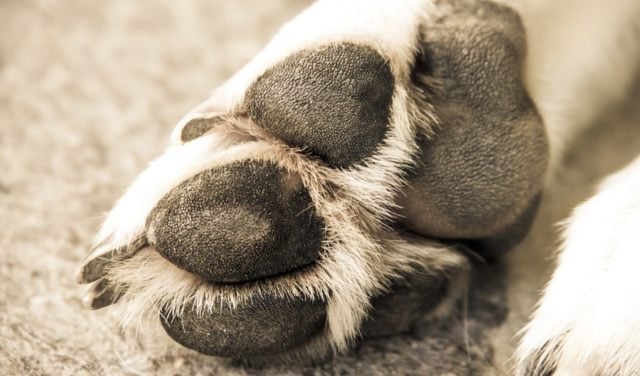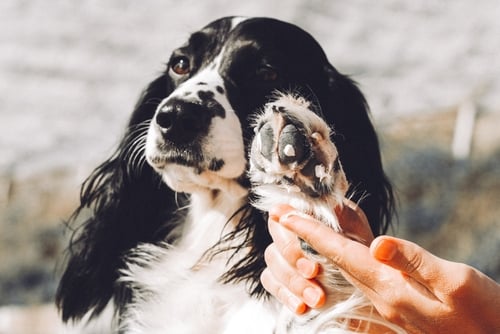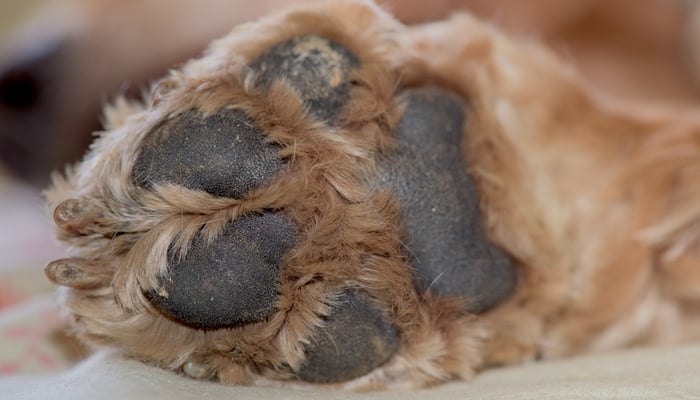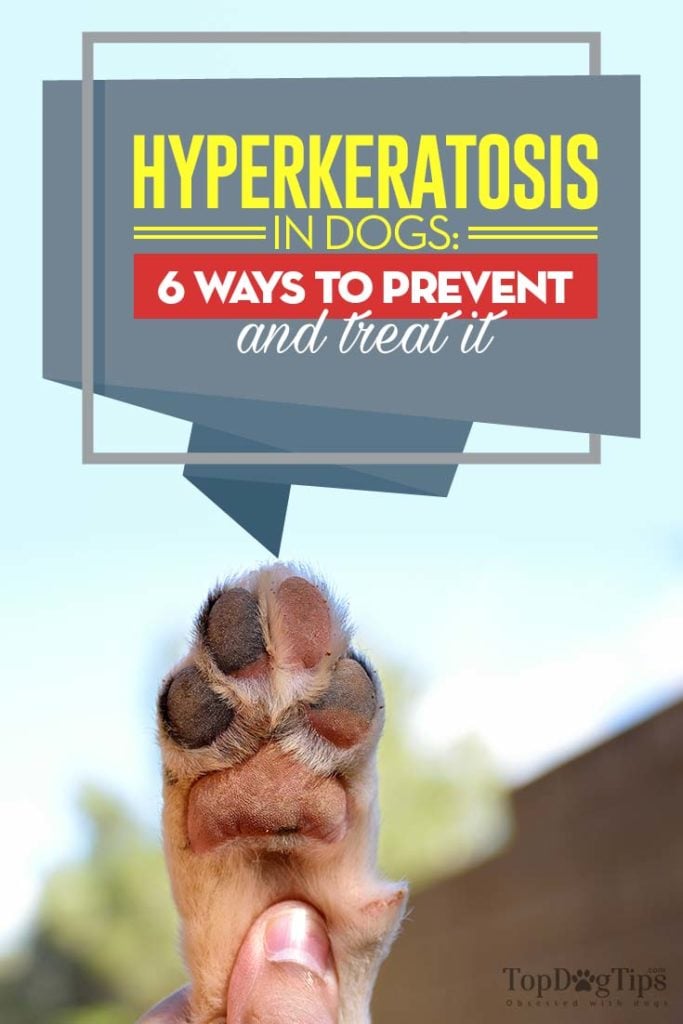
KEY TAKEAWAYS:
– Hyperkeratosis in dogs is the excessive production of keratin that causes their skin to thicken, commonly on their paws and nose.]
– Genetics, bacterial or parasitic infections, and Zinc deficiency are some of the common reasons for hyperkeratosis in dogs.
– Hyperkeratosis is untreatable. It is also not a medical emergency.
– Managing hyperkeratosis is important to ease their discomfort and improve Fido's quality of life. Your vet may prescribe balms or creams.
Table of Contents
- What is Hyperkeratosis in Dogs?
- What are the Signs of Hyperkeratosis in Dogs?
- What are the Causes of Hyperkeratosis in Dogs?
- How do Vets Diagnose Hyperkeratosis in Dogs?
- How Is Hyperkeratosis Treated in Dogs?
- 6 Tips to Manage Hyperkeratosis in Dogs
- Tips to Prevent Dog Paw Keratosis or Reduce its Severity
- Common Questions about Paw and Nasal Hyperkeratosis
- Hyperkeratosis in Dogs: Before You Go…
Have you noticed your dog's hard and crusty nose and paw pads? Do you suspect hyperkeratosis?
Hyperkeratosis in dogs is generally harmless and is rarely a medical emergency.
But that's not to say it won't cause any complications in the long run when left unmanaged.
In this article, we will discuss everything you need to learn about hyperkeratosis in dogs, including the signs and symptoms, its causes, and how you can best manage it at home.
To ensure accurate information, this article has been reviewed and edited by one of our resident veterinarians, Dr. Myles Rowley, DVM.
Jump to a section:

What is Hyperkeratosis in Dogs?
Our dog's body naturally makes keratin, a protein that makes up the majority of their nails, fur, and the outer coating of their skin.
Hyperkeratosis, then, is a condition where your dog's body makes too much keratin.
That keratin continues to grow and forms a hard crusty shell on your dog's nose and/or paw pads.
When that happens, especially on the nose, your dog won't be able to use them as they should. This is what's called nasal hyperkeratosis.
The same goes for their paws. Those hard crusty shells on the pads of their feet can make them extremely sensitive.
What are the Signs of Hyperkeratosis in Dogs?
Here are the main signs and symptoms of hyperkeratosis in dogs:
Thickened, callused skin patches: These are the most obvious signs as the skin develops hard, thickened areas that may appear scaly.
Common sites are the elbows, knees, hocks, and pressure points.
Dry, flaky skin: The thickened skin may have a dry, flaky appearance and feel rough to the touch. It's often scaly like elephant skin.
Itching and discomfort: The affected areas may itch or cause the dog discomfort. They can lick, chew, or scratch at lesions.
Cracking or fissures: In severe cases, the thick skin can develop cracks or fissures that may bleed. Secondary infections are possible.
Smell: Thickened skin is more prone to trapping odor-causing bacteria so that lesions may have an unpleasant smell.
Changes in hair: Lesions may cause hair loss or abnormal hair growth around thickened skin patches.
Difficulty walking: In advanced cases with hock or leg involvement, a dog's gait may be altered due to pain or discomfort.
Other signs: Secondary issues like infections, inflammation, or swelling may also occur depending on the severity and underlying cause.
Hyperkeratosis causes tell-tale skin thickening that can impact Fido's quality of life.
They might find it painful to walk, and your dog's poor nose function will affect their daily activities.
View this post on Instagram
What are the Causes of Hyperkeratosis in Dogs?
Hyperkeratosis can have several causes.
Some dog breeds are more prone to this condition, while some medical illnesses can sometimes result in this as well.
The most common causes of hyperkeratosis in dogs are:
Genetics: Certain breeds like Labradors, Chesapeake Bay Retrievers, Golden Retrievers, and Terrier dogs have a genetic predisposition to this.
If this is the case, expect the symptoms to start appearing while your dog is still young, usually about four to nine months old.
The Dogue de Bordeaux and the Irish terrier are particularly prone to the type of hyperkeratosis called naso-plantar keratoderma (hyperkeratosis in the nose and feet).
With Labradors, the concern tends to be nasal parakeratosis (only in the nose).
Allergies: Food or environmental allergies can trigger an immune response leading to skin thickening.
Bacterial or fungal infections: Issues like yeast, staph, or ringworm infecting the skin can cause hyperkeratosis.
Parasites: Mites like Cheyletiella mites and scabies mites burrowing under the skin result in thickening.
One common parasitic infection that can cause hyperkeratosis is Leishmaniasis, from the biting sandfly parasite.
Hormonal imbalances: Conditions like Cushing's disease involving cortisol deregulation are linked.
Nutritional deficiencies: Zinc deficiency and lack of vitamins A, E, or essential fatty acids impair the skin's barrier function.
Trauma: Repeated friction or pressure on elbows, hocks, paws, etc., from hard surfaces can cause lesions.
Autoimmune diseases: Hypersensitivity disorders like pemphigus attack the skin cells, making it produce more keratin than what's necessary.
Other Endocrine diseases: Underlying issues like hypothyroidism or diabetes can affect the skin.
Neoplasia: Rarely, skin tumors can develop into thickened hyperkeratotic lesions.
Dog hyperkeratosis in itself can be uncomfortable for your pet, but it is not life-threatening.
However, if the cause is brought about by other diseases like an infection, for example, then it is best to bring Fido to the vet to be treated for that disease.
How do Vets Diagnose Hyperkeratosis in Dogs?
A physical exam is the first and foremost thing your veterinarian would do if you and your dog see them for a diagnosis.
They would examine your dog's paws, nose, and other commonly affected areas in their bodies to see if there's an excess build-up of skin or calluses.
They will look for lesions and note the appearance, distribution, and odor (if any).
The vet will also palpate for swelling or any pain that may add discomfort to your Fido's movements.
Apart from that, they may also perform:
Skin scrapings: Collect cells from the edge of lesions under a microscope to look for Demodex mites, bacteria, and fungi.
Fungal culture: Isolate any fungi present which may be causing or contributing to the condition.
Skin biopsy: Take a small sample of thickened skin for histopathology to examine tissue changes.
Allergy testing: Patch testing, intradermal tests, or blood tests to identify food or environmental allergies.
Bloodwork: Check for signs of infection, endocrine, or nutritional abnormalities underlying the skin issues.
Skin swabs: Collect samples for bacterial culture and sensitivity testing if infection is suspected.
Medical history: Note breed, diet, environment, and prior treatments to uncover potential causes.
Response to treatment: Monitor how lesions improve with anti-fungal, antibiotic, anti-yeast, or hypoallergenic diets to confirm diagnosis.
By combining physical exam findings with diagnostic test results, vets can identify the cause of hyperkeratosis and rule out other skin conditions.
View this post on Instagram
How Is Hyperkeratosis Treated in Dogs?
Unfortunately, there is no cure for hyperkeratosis in dogs.
However, you can definitely keep their condition under control.
Proper management will ease their discomfort and prevent any secondary infection from occurring.
That hard crusty shell can lead to skin infections and other problems. If that happens, your vet will prescribe antibiotics and/or topical creams.
But before it even gets into that, it's best to manage the condition the first moment you notice its symptoms.
You can even somewhat prevent this condition as part of their overall dog paw care routine.
So how do you manage hyperkeratosis in dogs?
You should definitely ask your vet about their recommended products and routines.
But to give you a general idea, we'll discuss how you can manage your dog's condition in the following section.

6 Tips to Manage Hyperkeratosis in Dogs
With a few simple treatments and lifestyle changes, having hyperkeratosis doesn't have to become a big problem for your dog or impact their life too much.
Here are some things you can do at home to manage hyperkeratosis in dogs and keep your pooch comfortable.
1. Get That Shell Removed
Because the keratin will keep growing and growing over your dog's paws or nose, you can periodically have it removed by a vet.
The video below shows how to do it. However, take note that it's still best to let a veterinarian do it to prevent you from accidentally hurting your dog or causing a skin infection.
If you have this done every few months, the symptoms of hyperkeratosis may not impact your dog's life much at all.
2. Use Skin Creams
Over-the-counter paw/nose balms or creams developed specifically for dogs with hyperkeratosis will help loosen up the shell and keep your dog's nose and paws moist so that your pup can still smell like they should be able to.
Some salves can help slow down keratin growth, although they can't totally cure dog hyperkeratosis.
3. Use Booties and/or Socks
Because your dog's feet may be sensitive, good footwear can help your dog be more comfortable.
So when taking your dog out, ensure their feet are protected so they won't come into contact with ice, cold snow, chemicals, or hot pavement.
While these are dangers to a dog's paws onto themselves, hyperkeratosis makes them even more hazardous.
Dogs with hyperkeratosis can burn their paw pads quicker or experience other paw pad injuries in heat or extreme cold.
Using dog shoes or socks with grips on the soles for your dog to wear outdoors or even around the house if you have cold floors like wood or tile floors will help.
4. Keep Your Dog's Nails Trimmed
When a dog has hyperkeratosis, it can be tough for pet owners to trim their nails without causing pain or injury.
But trimming your dog's nails regularly will keep your dog more comfortable.
If you're unsure about doing it yourself, then take the dog to a groomer or have your vet trim Fido's nails regularly to make it easier for your pup to walk without pain.
5. Let Your Dog Ride on a Stroller
If your dog likes to go for long walks outside, but the hyperkeratosis condition has progressed so far that it makes your pet's feet hurt after a short time, one option you have is a pet stroller.
It might seem silly to some dog owners, but a dog stroller will give your dog the fun of a walk or a run without hurting its feet.
This doesn't mean that your dog never walks again; rather, it's a solution for long walks outdoors.
Bring the stroller, let Fido walk or run with you until you notice the dog slowing down, limping, or acting like they're in pain, then get your pup into a stroller.
6. Give Your Dog a Sauna Experience
To keep the dog's skin under the keratin soft and moist and to soften the ridges of keratin on your dog's nose and paw pads, you can give your pooch some steam.
You cannot bring a dog into a sauna, but you can run the shower with the hot water on full blast until the bathroom is hot and steamy.
Don't turn on the exhaust fan.
Then sit in the steamy bathroom with your pet and let that hot steam soften up the skin and the keratin.
Your dog will breathe better and be a lot more comfortable afterward.
Tips to Prevent Dog Paw Keratosis or Reduce its Severity
One of the most important things you can do for your dog's overall health is to take him for annual checkups.
This will allow your vet to spot paw pad hyperkeratosis or any other potential issues.
If you live somewhere very hot or very cold, consider putting booties or socks on your dog.
This will protect your dog's skin on his paws.
By reducing irritation, you reduce the risk of health issues like hyperkeratosis.
You can also help prevent hyperkeratosis by protecting your dog from environmental factors.
This means avoiding dirty water, keeping your yard clean, and giving your pup a parasite defense.
You can also reduce the risk of hyperkeratosis and other skin conditions by making sure you feed your dog a balanced diet.
This can prevent mineral deficiencies, such as zinc, which could lead to hyperkeratosis.
Common Questions about Paw and Nasal Hyperkeratosis
If you still have questions about hyperkeratosis on your dog's paw pads or nose, the following FAQs should help clear them up for you.
How Do You Get Rid of Hyperkeratosis?
Your dog's vet can occasionally remove the excess skin on the affected areas of your dog's body.
He will also confirm there are no secondary infections.
Unfortunately, hyperkeratosis will always return, so any treatment is just a short-term solution designed to relieve your dog's discomfort.
What Dogs Are Prone to Hyperkeratosis?
Certain breeds, including cocker spaniels and brachycephalic breeds, may have a higher risk of developing hyperkeratosis.
Other higher-risk breeds include boxers, Dogues de Bordeaux, English bulldogs, Frenchies, Irish terriers, Bedlington terriers, and Golden Retrievers.
If you have one of these breeds, pay attention to warning signs, such as dry skin, cracked skin, and discomfort.
How Do I Know If My Dog Has Hyperkeratosis?
To check if your furry friend has hyperkeratosis, you must examine him for health problems.
Please pay particular attention to his ears, nose, and pads, as well as his behavior related to those parts of his body.
Check for a crusty layer, bleeding, cracks, or a rough, dry appearance in these areas of the body.
You also want to be on the lookout for reduced activity, limping, and frequently licking his paws.
This can also be a warning sign if your dog's ears, nose, or paws are sensitive.
If you suspect your dog has hyperkeratosis or another potential skin issue, take him to the vet for professional care and diagnosis.
Can I Put Vaseline on My Dog?
You can put Vaseline on your dog to treat skin conditions, including hyperkeratosis. However, there are better options.
If you apply Vaseline somewhere your pup can reach, he may consume too much and develop an upset stomach. This can even lead to diarrhea and vomiting.
Instead, ask your vet for other suggestions with natural ingredients that are less likely to cause tummy aches.
Examples include jojoba oil, manuka honey, Shea butter, and Epsom salt.
Can I Put Coconut Oil on My Dog?
Yes, you can put coconut oil on your dog. It is safe for dogs in small quantities, including if they eat it. Just make sure to opt for virgin coconut oil for the best results.
Can You Remove Excess Skin to Treat Your Dog's Paw Pad Hyperkeratosis?
Yes, you can sometimes remove excess skin as a way to improve your dog's comfort.
However, it would help if you never attempted this yourself without first consulting your vet.
Your vet must teach you how to remove the excess, which is not the simplest task.
It is also worth noting that depending on the state of the excess skin on your dog's paw, your vet may suggest you DO NOT remove the excess yourself.
Instead, they may require you to bring your dog in periodically.
Listen to your vet if he says your pup is not a good candidate for at-home dog paw hyperkeratosis skin removal. Remember that dogs squirm.
If the skin is already challenging to remove and your dog squirms, you can seriously injure your pup.
Hyperkeratosis in Dogs: Before You Go…
Hyperkeratosis in dogs can make it difficult for your four-legged buddy to walk and stand.
While hyperkeratosis is typically benign, more severe occurrences will require medical attention for your dog.
Although there is no known cure, the existing treatments can help your dog live a healthier life.
Our best course of action as pet parents is always to maintain a clean home to guard against infectious agents.
Don't forget to get the essential vaccines for your Fido.
Last but not least, you can talk about it with the vet to ensure your furry friend receives the greatest care.
READ NEXT:
- 9 Tips On How To Protect Your Dog's Paws In Winter
- How to Treat an Infected Paw on a Dog
- How to Stop a Dog From Licking Paws













